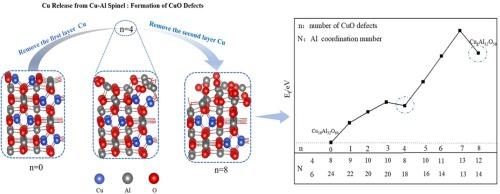Evidence for the dynamic change of surface structure of Cu-Al spinel: a DFT study
IF 6.9
2区 材料科学
Q2 CHEMISTRY, PHYSICAL
引用次数: 0
Abstract
Using density functional theory with dispersion correction and U-parameter (DFT + U-D3) method, the Cu release process from spinel structure is simulated by stepwise removal of CuO from spinel-structured Cu16Al32O64, forming Cu16-nAl32O64-n with CuO defects (VCuO)n (n = 1–8). The stepwise formation energies of the Cu16-nAl32O64-n exhibit a complex variation trend with the increasing n, revealing an initial decline from n = 1 to n = 4 and increase with n = 5–7 followed by sharp decrease at n = 8. Interestingly, the stepwise formation energies even become negative (−0.26 eV for n = 4 and −1.63 eV for n = 8, respectively). Hence, the total formation energies of the Cu16-nAl32O64-n system demonstrate an increasing trend with two energy reductions at n = 4 and n = 8, respectively. It was also found that the formation of CuO defect induced significant changes in the cationic coordination environment, leading to atomic rearrangement and lattice distortion. As the number of defects increases, the coordination number of some Al atoms decreases from hexa-coordination to lower-coordinations (primarily tetra-coordination, followed by penta-coordination and rarely tri-coordination).The findings of this study are consistent with the experimental data obtained during the sustained release catalysis, validating the dynamic changes in the surface structure during the catalytic process and laying a foundation for further research on the releasing mechanism of Cu-Al spinel.

Cu-Al尖晶石表面结构动态变化的证据:DFT研究
利用带色散校正的密度泛函数理论和u参数(DFT + U-D3)方法,模拟了尖晶石结构Cu16Al32O64中CuO的逐步去除,形成Cu16-nAl32O64-n和CuO缺陷(VCuO)n( = 1-8)的Cu释放过程。随着n的增加,Cu16-nAl32O64-n的逐步生成能呈现出复杂的变化趋势,从n = 1到n = 4,初始值呈下降趋势,随着n = 5-7而增加,然后在n = 8时急剧下降。有趣的是,逐步形成的能量甚至变为负值(n = 4时为- 0.26 eV, n = 8时为- 1.63 eV)。因此,Cu16-nAl32O64-n体系的总生成能呈增加趋势,分别在n = 4和n = 8处有两次能量降低。还发现,CuO缺陷的形成引起阳离子配位环境的显著变化,导致原子重排和晶格畸变。随着缺陷数的增加,一些Al原子的配位数从六配位逐渐降低到更低的配位(主要是四配位,其次是五配位,很少是三配位)。本研究结果与缓释催化过程中获得的实验数据一致,验证了催化过程中表面结构的动态变化,为进一步研究Cu-Al尖晶石的释放机理奠定了基础。
本文章由计算机程序翻译,如有差异,请以英文原文为准。
求助全文
约1分钟内获得全文
求助全文
来源期刊

Applied Surface Science
工程技术-材料科学:膜
CiteScore
12.50
自引率
7.50%
发文量
3393
审稿时长
67 days
期刊介绍:
Applied Surface Science covers topics contributing to a better understanding of surfaces, interfaces, nanostructures and their applications. The journal is concerned with scientific research on the atomic and molecular level of material properties determined with specific surface analytical techniques and/or computational methods, as well as the processing of such structures.
 求助内容:
求助内容: 应助结果提醒方式:
应助结果提醒方式:


